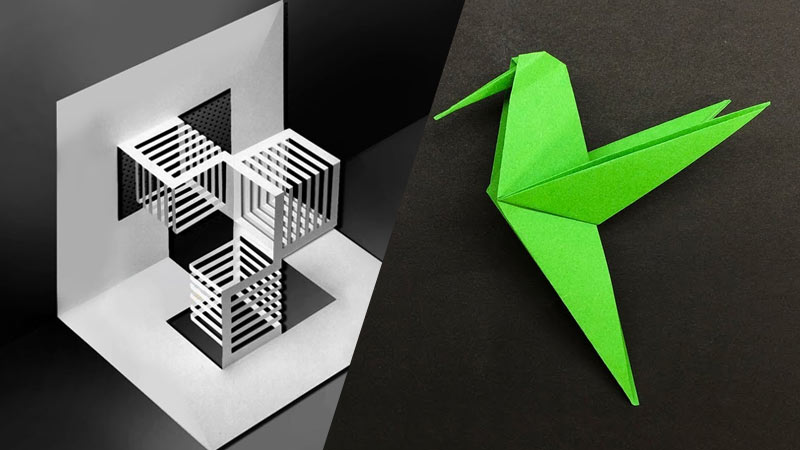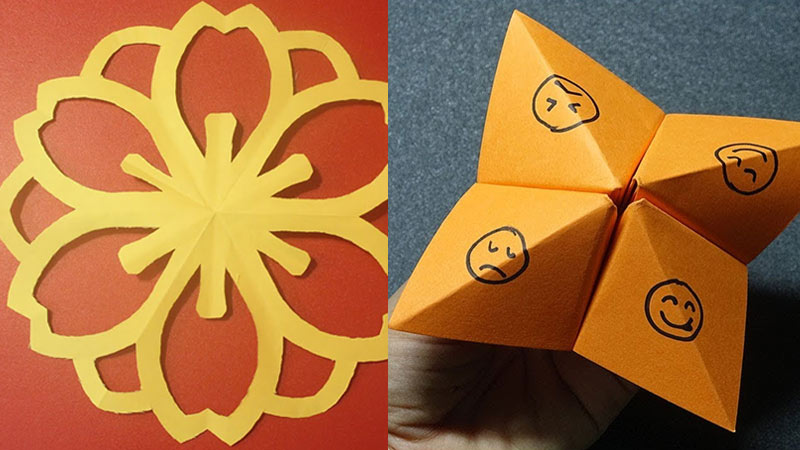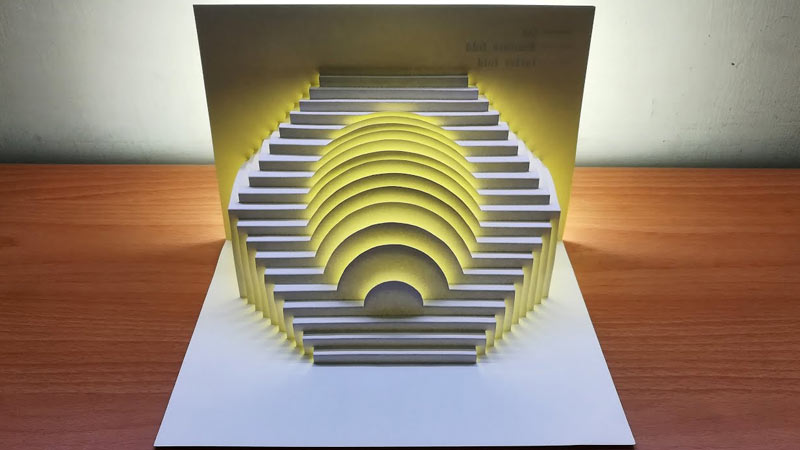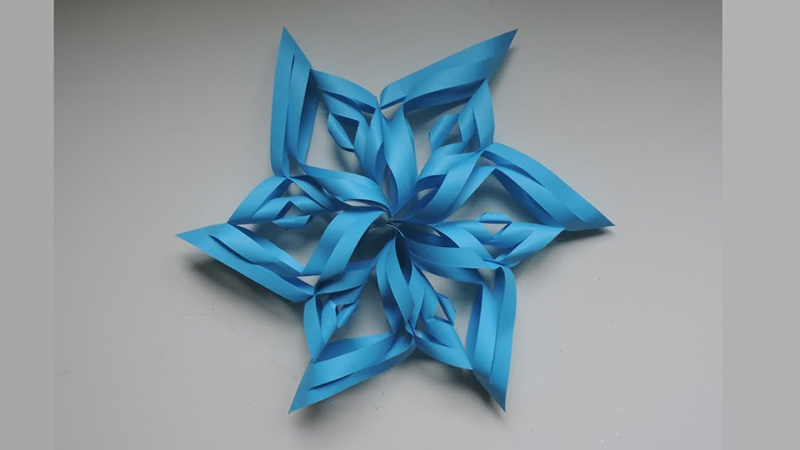Origami and kirigami, both rooted in Japanese artistic traditions, share the common thread of paper manipulation but diverge in technique.
Origami, derived from “ori” (folding) and “gami” (paper), involves intricate folding to craft sculptures without cutting.
In contrast, kirigami, a fusion of “Kiri” (cut) and origami introduces precise cutting alongside folding, allowing for more dynamic and interactive creations. This distinction transforms kirigami into a realm of possibilities beyond origami’s constraints.
The interplay of folding and cutting techniques in kirigami adds layers of complexity, giving rise to pop-up cards, intricate designs, and robust sculptures, showcasing the evolution and versatility within the rich tapestry of paper art.

What Is Kirigami?
Kirigami is a traditional Japanese paper art that involves both folding and cutting paper to create intricate designs.
Derived from the words “kiri” (cut) and “gami” (paper), kirigami allows artists to go beyond the constraints of traditional origami by incorporating precise cutting techniques.
This dynamic craft is renowned for its ability to produce intricate and often interactive creations, such as pop-up cards, decorative patterns, and three-dimensional sculptures.
Kirigami adds an exciting dimension to the world of paper art, enabling artists to craft detailed and visually stunning pieces by skillfully manipulating paper through a combination of folding and cutting methods.
What Is Origami?
Origami is the ancient Japanese art of paper folding, where intricate sculptures and designs are created by folding a single sheet of paper without cutting or gluing.
Rooted in Japanese culture, “ori” means folding, and “gami” means paper. Origami’s essence lies in precision and creativity, transforming flat sheets into three-dimensional masterpieces through a series of intricate folds.
This meditative and precise craft has evolved into a global hobby, celebrated for its therapeutic qualities and diverse range of creations, including animals, geometric shapes, and complex modular structures. Origami exemplifies the beauty of simplicity, turning a plain sheet into captivating art.
What Is the Difference Between Kirigami and Origami?

Origami and kirigami are both traditional Japanese paper crafts that involve the manipulation of paper to create intricate and beautiful designs.
While they share some similarities, there are distinct differences between the two techniques. Origami focuses on the art of folding paper to create sculptures, while kirigami incorporates cutting as well.
In the table below, we will delve into the key distinctions between origami and kirigami, highlighting their unique characteristics:
| Criteria | Origami | Kirigami |
| Definition | The art of folding paper without cutting. | The art of folding and cutting paper. |
| Cutting | It can be more intricate due to cutting. | Cutting is an integral part of the process. |
| Technique | Emphasis on folding techniques. | Incorporates folding and cutting methods. |
| Types of creations | Sculptures, animals, geometric shapes. | Pop-up cards, dynamic and interactive designs. |
| Complexity | It can incorporate moving parts and 3D effects due to cutting. | It may involve additional tools like scissors. |
| Tools | Paper and hands are the primary tools. | It often involves complex folding sequences. |
| Popularity | Globally popular as a calming, creative hobby. | Commonly used in card making and pop-up books. |
| Traditional Use | Used in religious ceremonies and artistic expression. | Applied in decorative arts and practical applications. |
| Endurance | Origami sculptures are more delicate and susceptible to wear. | Kirigami creations are more robust due to cutting and can withstand handling better. |
| Dynamic Elements | Limited movement in origami creations. | Can incorporate moving parts and 3D effects due to cutting. |
| Adaptability | Limited in terms of adding external elements. | Offers more versatility for incorporating various materials and textures. |
| Learning Curve | Beginners may find certain folds challenging. | Cutting techniques add an additional layer of complexity for beginners. |
| Notable Examples | Crane, frog, and traditional paper cranes. | Pop-up cards, paper snowflakes, and intricate paper designs. |
| Cultural Significance | Deeply rooted in Japanese culture and traditions. | Originated from origami but evolved with a broader artistic scope. |
Popular Kirigami Designs
Popular kirigami designs encompass a wide range of intricate and visually captivating creations that leverage both folding and cutting techniques.
Some notable examples include:
Pop-Up Cards

Kirigami pop-up cards are miniature marvels, combining intricate cutting techniques with clever folding to create surprise elements.
Designs range from festive scenes to intricate landscapes, and the artistry lies in the precision of the cuts and folds, allowing the cards to unfold into captivating three-dimensional displays.
Popular occasions for these cards include birthdays, holidays, and special celebrations, making them a cherished and personalized form of greeting.
Architectural Models
Kirigami architectural models showcase the meticulous craftsmanship of artists who transform flat sheets of paper into detailed replicas of iconic buildings.
From intricate pagodas to modern skyscrapers, these designs highlight the versatility of kirigami in capturing the essence of architectural marvels on a miniature scale.
The interplay between cutting and folding allows for the recreation of structural details, making these models both visually striking and technically impressive.
Floral Patterns
Kirigami floral designs are a delicate fusion of precision and artistry. Artists craft intricate flower petals, leaves, and stems through careful cutting techniques, creating stunningly realistic representations of various blooms.
From the romantic allure of roses to the ephemeral beauty of cherry blossoms, kirigami floral patterns bring the essence of nature into the realm of paper art, offering a unique and enduring way to appreciate botanical beauty.
Animal Sculptures
Kirigami animal sculptures capture the grace and charm of the animal kingdom through a combination of folding and cutting techniques.
Artists intricately carve out details, creating lifelike representations of birds, fish, mammals, and more.
Whether a soaring eagle, a majestic lion, or a whimsical sea creature, these kirigami designs showcase the craft’s versatility in bringing the natural world’s diversity to life in paper form.
Landscape Scenes
Kirigami landscape scenes transport viewers into enchanting worlds created through meticulously cut and folded paper layers.
From serene mountain ranges to lush forests, these designs use depth and dimension to evoke a sense of immersion.
Kirigami artists skillfully manipulate paper to capture the beauty of natural landscapes, providing a unique and contemplative artistic experience.
Abstract Art
Kirigami’s adaptability shines in abstract art, where artists push the boundaries of traditional representations.
Through experimental compositions, intricate patterns, and asymmetrical designs, kirigami becomes a canvas for artistic expression beyond recognizable forms.
These abstract kirigami creations showcase the endless possibilities of the craft as a medium for unconventional and avant-garde artistic exploration.
Holiday Decorations
Kirigami is vital in holiday decorations, offering a handmade touch to festive environments.
From intricately cut snowflakes that delicately fall from ceilings to Christmas trees adorned with paper ornaments, these designs add a unique and personal flair to seasonal celebrations.
Kirigami’s ability to capture the spirit of holidays makes it a cherished craft for creating memorable and visually appealing decorations.
Mechanical Creations
Kirigami’s integration with mechanical elements adds a fascinating dimension to paper art. Artists create designs with movable parts, allowing for kinetic sculptures that move and transform.
These mechanical kirigami creations showcase a harmonious blend of engineering principles and artistic ingenuity, pushing the boundaries of what can be achieved with the marriage of paper and motion.
Popular Kirigami for Beginners
For beginners venturing into the world of kirigami, there are several accessible and rewarding designs that offer a gentle introduction to the art form.
These designs emphasize simplicity while still allowing newcomers to experience the beauty of combining folding and cutting techniques.
Here are some popular kirigami designs for beginners:
Paper Snowflakes

Craft elegant paper snowflakes by folding and cutting out patterns from square or circular paper. Begin with basic designs, gradually progressing to more intricate shapes as proficiency grows.
The delicate and symmetrical nature of snowflakes allows beginners to experiment with different cutting techniques, making it a seasonal and enjoyable kirigami activity.
Basic Pop-Up Cards
Start with uncomplicated pop-up card designs featuring simple shapes like hearts, stars, or balloons. These designs often require straightforward folding and cutting along designated lines.
The cut-out shapes pop up as the card is opened, creating a visually appealing and delightful effect.
This introductory project is an excellent way to understand the fundamentals of kirigami and its interactive nature.
Simple Animals
Explore the world of kirigami by creating simple animal figures like butterflies, fish, or birds. These designs typically involve basic folding and cutting techniques to form recognizable shapes.
Beginners can choose templates or experiment with their own variations, gaining confidence in manipulating paper to bring charming animal characters to life.
Flower Blossoms
Begin with uncomplicated kirigami flower designs, focusing on creating petals and basic floral shapes.
This project allows beginners to practice precision in cutting and folding, resulting in visually appealing and customizable paper flowers. Gradually advance to more intricate arrangements, enhancing both skill and creativity.
Heart Cut-Outs
Craft heart-shaped designs with cut-out patterns as a beginner-friendly kirigami project.
By folding paper and carefully cutting along simple lines, individuals can create charming heart motifs suitable for various applications, including card embellishments, decorations, or personalized gifts.
Decorative Bookmarks
Dive into kirigami with the creation of decorative bookmarks. Explore various folding and cutting techniques to design unique and functional bookmarks.
This project encourages experimentation with shapes, patterns, and colors, providing beginners with a canvas for expressing their creativity while producing practical and personalized items.
Sunbursts or Rays
Experiment with sunburst or ray designs by folding and cutting paper into radiating patterns. These designs are simple yet visually striking, making them an ideal kirigami project for beginners.
The technique involves folding the paper symmetrically and cutting along specific lines to create sunburst effects, offering a visually appealing introduction to the art form.
Symmetrical Patterns
Explore the concept of symmetry in kirigami by creating simple symmetrical patterns. This project involves folding the paper to ensure mirrored designs on both sides.
Beginners can experiment with various shapes and structures, gaining a foundational understanding of symmetry in kirigami designs, which is a stepping stone for more intricate projects.
FAQs
What is the fundamental difference between origami and kirigami?
Origami involves folding paper to create intricate sculptures without cutting, while kirigami incorporates both folding and precise cutting techniques, allowing for more dynamic and interactive designs.
Can you use cutting in origami?
No, origami strictly adheres to folding techniques without cutting or gluing. The focus is on manipulating paper through folds to create various shapes and structures.
What kind of creations can you make with origami?
Origami is versatile, allowing the creation of sculptures, animals, and geometric shapes. Its emphasis lies in the precision of folding sequences.
How does kirigami differ from origami in terms of complexity?
Kirigami can be more intricate due to the introduction of cutting. This complexity allows for creating pop-up cards, interactive designs, and sculptures with more intricate details.
Are there cultural differences between origami and kirigami?
Origami has deeper roots in Japanese culture and is often used in religious ceremonies. While originating from origami, Kirigami has evolved with a broader artistic scope and is commonly applied in decorative arts and practical applications worldwide.
To Recap
While origami and kirigami originate from the ancient art of Japanese paper folding, their distinctions lie in the applied techniques.
Origami emphasizes the elegance of folding and producing intricate sculptures without the use of cuts or glue.
On the other hand, kirigami introduces precision cutting to the folding process, allowing for dynamic, three-dimensional creations with a broader range of possibilities.
Each technique carries its own charm, with origami embodying simplicity and precision and kirigami showcasing complexity and interactivity.
Together, they exemplify the boundless creativity achievable through the delicate manipulation of paper, providing artists and enthusiasts with distinct avenues to explore the captivating world of paper art.
Leave a Reply